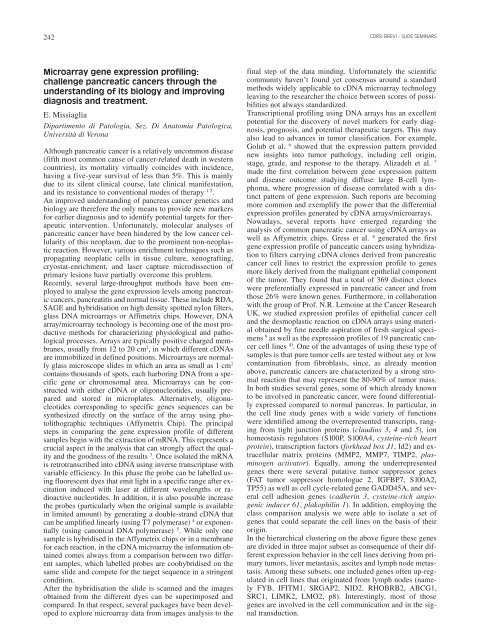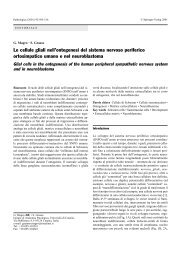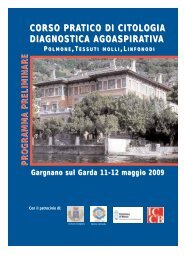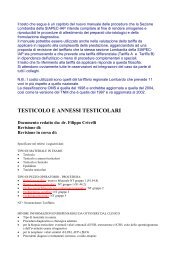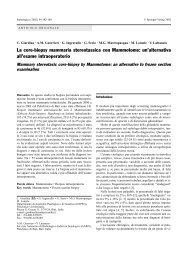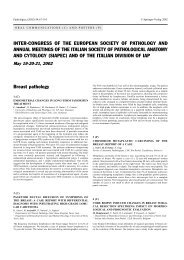You also want an ePaper? Increase the reach of your titles
YUMPU automatically turns print PDFs into web optimized ePapers that Google loves.
242<br />
Microarray gene expression profiling:<br />
challenge pancreatic cancers through the<br />
understanding of its biology and improving<br />
diagnosis and treatment.<br />
E. Missiaglia<br />
Dipartimento di Patologia, Sez. Di Anatomia Patologica,<br />
Università di Verona<br />
Although pancreatic cancer is a relatively uncommon disease<br />
(fifth most common cause of cancer-related death in western<br />
countries), its mortality virtually coincides with incidence,<br />
having a five-year survival of less than 5%. This is mainly<br />
due to its silent clinical course, late clinical manifestation,<br />
and its resistance to conventional modes of therapy 1 2 .<br />
An improved understanding of pancreas cancer genetics and<br />
biology are therefore the only means to provide new markers<br />
for earlier diagnosis and to identify potential targets for therapeutic<br />
intervention. Unfortunately, molecular analyses of<br />
pancreatic cancer have been hindered by the low cancer cellularity<br />
of this neoplasm, due to the prominent non-neoplastic<br />
reaction. However, various enrichment techniques such as<br />
propagating neoplatic cells in tissue culture, xenografting,<br />
cryostat-enrichment, and laser capture microdissection of<br />
primary lesions have partially overcome this problem.<br />
Recently, several large-throughput methods have been employed<br />
to analyse the gene expression levels among pancreatic<br />
cancers, pancreatitis and normal tissue. These include RDA,<br />
SAGE and hybridisation on high density spotted nylon filters,<br />
glass DNA microarrays or Affimetrix chips. However, DNA<br />
array/microarray technology is becoming one of the most productive<br />
methods for characterizing physiological and pathological<br />
processes. Arrays are typically positive charged membranes,<br />
usually from 12 to 20 cm 2 , in which different cDNAs<br />
are immobilized in defined positions. Microarrays are normally<br />
glass microscope slides in which an area as small as 1 cm 2<br />
contains thousands of spots, each harboring DNA from a specific<br />
gene or chromosomal area. Microarrays can be constructed<br />
with either cDNA or oligonucleotides, usually prepared<br />
and stored in microplates. Alternatively, oligonucleotides<br />
corresponding to specific genes sequences can be<br />
synthesized directly on the surface of the array using photolithographic<br />
techniques (Affymetrix Chip). The principal<br />
steps in comparing the gene expression profile of different<br />
samples begin with the extraction of mRNA. This represents a<br />
crucial aspect in the analysis that can strongly affect the quality<br />
and the goodness of the results 3 . Once isolated the mRNA<br />
is retrotranscribed into cDNA using inverse transcriptase with<br />
variable efficiency. In this phase the probe can be labelled using<br />
fluorescent dyes that emit light in a specific range after excitation<br />
induced with laser at different wavelengths or radioactive<br />
nucleotides. In addition, it is also possible increase<br />
the probes (particularly when the original sample is available<br />
in limited amount) by generating a double-strand cDNA that<br />
can be amplified linearly (using T7 polymerase) 4 or exponentially<br />
(using canonical DNA polymerase) 5 . While only one<br />
sample is hybridised in the Affymetrix chips or in a membrane<br />
for each reaction, in the cDNA microarray the information obtained<br />
comes always from a comparison between two different<br />
samples, which labelled probes are coohybridised on the<br />
same slide and compete for the target sequence in a stringent<br />
condition.<br />
After the hybridisation the slide is scanned and the images<br />
obtained from the different dyes can be superimposed and<br />
compared. In that respect, several packages have been developed<br />
to explore microarray data from images analysis to the<br />
CORSI BREVI - SLIDE SEMINARS<br />
final step of the data minding. Unfortunately the scientific<br />
community haven’t found yet consensus around a standard<br />
methods widely applicable to cDNA microarray technology<br />
leaving to the researcher the choice between scores of possibilities<br />
not always standardized.<br />
Transcriptional profiling using DNA arrays has an excellent<br />
potential for the discovery of novel markers for early diagnosis,<br />
prognosis, and potential therapeutic targets. This may<br />
also lead to advances in tumor classification. For example,<br />
Golub et al. 6 showed that the expression pattern provided<br />
new insights into tumor pathology, including cell origin,<br />
stage, grade, and response to the therapy. Alizadeh et al. 7<br />
made the first correlation between gene expression pattern<br />
and disease outcome studying diffuse large B-cell lymphoma,<br />
where progression of disease correlated with a distinct<br />
pattern of gene expression. Such reports are becoming<br />
more common and exemplify the power that the differential<br />
expression profiles generated by cDNA arrays/microarrays.<br />
Nowadays, several reports have emerged regarding the<br />
analysis of common pancreatic cancer using cDNA arrays as<br />
well as Affymetrix chips. Gress et al. 8 generated the first<br />
gene expression profile of panceatic cancers using hybridization<br />
to filters carrying cDNA clones derived from pancreatic<br />
cancer cell lines to restrict the expression profile to genes<br />
more likely derived from the malignant epithelial component<br />
of the tumor. They found that a total of 369 distinct clones<br />
were preferentially expressed in pancreatic cancer and from<br />
those 26% were known genes. Furthermore, in collaboration<br />
with the group of Prof. N.R. Lemoine at the Cancer Research<br />
UK, we studied expression profiles of epithelial cancer cell<br />
and the desmoplastic reaction on cDNA arrays using material<br />
obtained by fine needle aspiration of fresh surgical specimens<br />
9 as well as the expression profiles of 19 pancreatic cancer<br />
cell lines 10 . One of the advantages of using these type of<br />
samples is that pure tumor cells are tested without any or low<br />
contamination from fibroblasts, since, as already mention<br />
above, pancreatic cancers are characterized by a strong stromal<br />
reaction that may represent the 80-90% of tumor mass.<br />
In both studies several genes, some of which already known<br />
to be involved in pancreatic cancer, were found differentially<br />
expressed compared to normal pancreas. In particular, in<br />
the cell line study genes with a wide variety of functions<br />
were identified among the overrepresented transcripts, ranging<br />
from tight junction proteins (claudins 3, 4 and 5), ion<br />
homeostasis regulators (S100P, S100A4, cysteine-rich heart<br />
protein), transcription factors (forkhead box J1, Id2) and extracellular<br />
matrix proteins (MMP2, MMP7, TIMP2, plasminogen<br />
activator). Equally, among the underrepresented<br />
genes there were several putative tumor suppressor genes<br />
(FAT tumor suppressor homologue 2, IGFBP7, S100A2,<br />
TP55) as well as cell cycle-related gene GADD45A, and several<br />
cell adhesion genes (cadherin 3, cysteine-rich angiogenic<br />
inducer 61, plakophilin 1). In addition, employing the<br />
class comparison analysis we were able to isolate a set of<br />
genes that could separate the cell lines on the basis of their<br />
origin.<br />
In the hierarchical clustering on the above figure these genes<br />
are divided in three major subset as consequence of their different<br />
expression behavior in the cell lines deriving from primary<br />
tumors, liver metastasis, ascites and lymph node metastasis.<br />
Among these subsets, one included genes often up-regulated<br />
in cell lines that originated from lymph nodes (namely<br />
FYB, IFITM1, SRGAP2, NID2, RHOBRB2, ABCG1,<br />
SRC1, LIMK2, LMO2, p8). Interestingly, most of those<br />
genes are involved in the cell communication and in the signal<br />
transduction.


